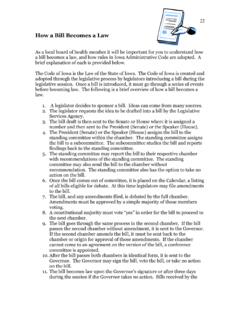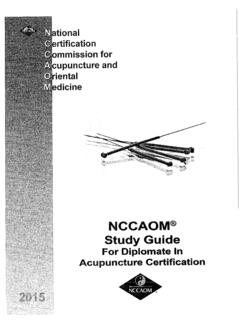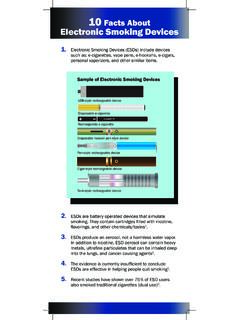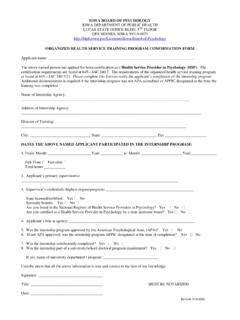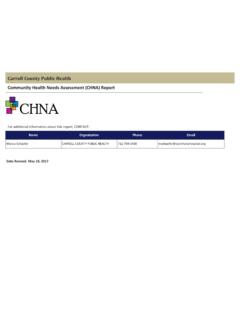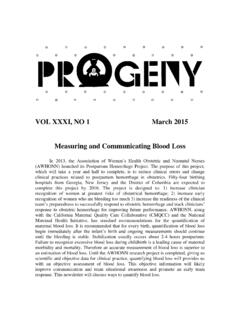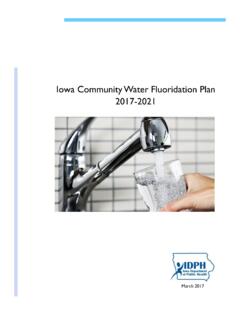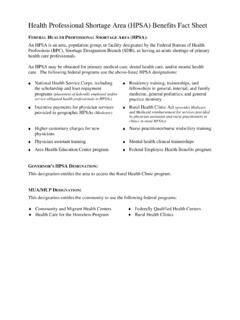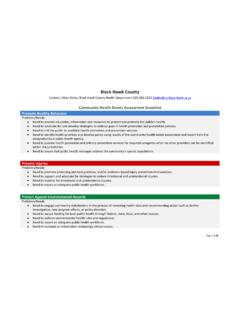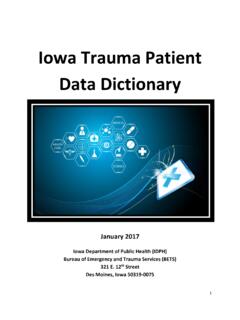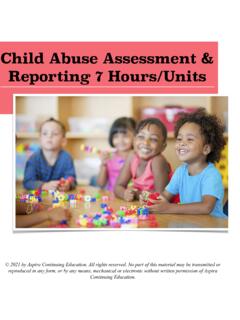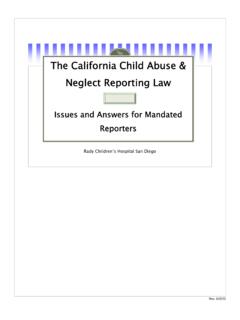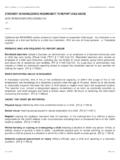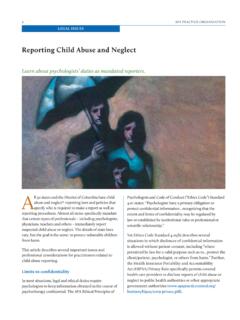Transcription of Comm. 164 Child Abuse: A Guide for Mandatory Reporters
1 Child abuse : A Guide for Mandatory Reporters Comm. 164 July 1, 2011 To make a report of suspected Child abuse , call the toll-free 24-hour hotline: 1- 800-362-2178 Child abuse : A Guide for Mandatory Reporters 1 Comm. 164 July 1, 2010 Table of Contents Child abuse Overview ..1 National Data ..2 Iowa Response ..3 Am I a Mandatory Reporter of Child abuse ? ..5 Health ..6 Education ..7 Child Care ..8 Mental Health ..8 Law Enforcement ..8 Others Required to report ..9 How Do I report Child abuse ? ..9 Reporting Procedures ..10 Waiver of Confidentiality ..11 Immunity From Liability ..12 Sanctions for Failure to report Child abuse ..12 Sanctions for Reporting False Information ..12 Indicators of Possible Child abuse ..13 What Is Child abuse Under Iowa Law? ..15 Caretaker.
2 16 Educators as Caretakers ..17 Children as Caretakers ..17 Physical abuse ..18 Mental Injury ..18 Sexual abuse ..19 Denial of Critical Care ..20 Child Prostitution ..22 Presence of Illegal Drugs ..22 Manufacturing or Possession of a Dangerous Substance ..23 Bestiality in the Presence of a Minor ..24 Allows Access by a Registered Sex Offender ..24 Allows Access to Obscene Material ..24 2 Child abuse : A Guide for Mandatory Reporters July 1, 2010 Comm. 164 How Does DHS Respond? ..24 Intake ..24 Reports from Multiple Reporters ..25 Time Frame for Deciding Whether to Accept a report for Assessment ..25 Accepted Intakes ..26 Rejected Intakes ..26 Case Evaluation of the Alleged abuse ..28 Observation of the Alleged Child Victim ..28 Interviews with Subjects of the report and Other Sources.
3 29 Gathering Documentation ..30 Evaluation of the Safety of and Risk to the Child ..31 Determination if abuse Occurred ..32 Determination if report Is Placed on the Child abuse Registry ..32 Assessment of Family s Strengths and Needs ..34 Preparation of Reports and Forms ..35 What Happens After the Assessment? ..37 Service Recommendations and Referrals ..37 Removal of a Child ..39 Removal by Ex Parte Court Order ..39 Removal of a Child by a Peace Officer or a Physician ..41 Removal With Parent s Consent ..43 Juvenile Court Child in Need of How Is Child abuse Information Treated? ..47 Protective Disclosure ..47 Disposition of Reports ..47 Requests for Correction and Appeals ..48 Access to Child abuse Information ..49 Civil and Criminal Liability Regarding Child abuse Information.
4 51 What Training Do Mandatory Reporters Need? ..52 Review Questions ..54 Safe Haven for Newborns ..62 report of Suspected Child abuse ..63 Child abuse : A Guide for Mandatory Reporters 1 Comm. 164 July 1, 2005 Child abuse Overview Child abuse is not a new phenomenon. The abuse and neglect of children has been documented for more than two thousand years. However, attempts to prevent Child abuse are relatively new. The first documented legal response to Child abuse in the United States occurred in 1874. The New York Society for the Prevention of Cruelty to Animals pleaded in court to have an eight-year-old Child removed from her abusive and neglectful environment. Since there were no Child abuse laws, the Society argued that the Child was, in fact, an animal, and should be provided the same protection as other animals.
5 During the last few decades of the 1800s, societies to protect children from cruelty were formed in many states. The next movement to protect children came as the result of several pediatricians publishing articles about children suffering multiple fractures and brain injuries at the hands of their caretakers. In 1961, Dr. C. Henry Kempe, then president of the American Academy of Pediatrics, held a conference on the battered Child syndrome, in which he outlined a duty to the Child to prevent repetition of trauma. The Battered Child Syndrome Conference resulted in many states passing laws to protect children from physical abuse . Child abuse is now recognized as a problem of epidemic proportions. Child abuse has serious consequences that may remain as indelible pain throughout the victim s lifetime.
6 The violence and negligence of parents and caretakers serve as a model for children as they grow up. The Child victims of today, without protection and treatment, may become the Child abusers of tomorrow. As with any social issue, Child abuse is a problem for the entire community. Achieving the goals of protective services requires the coordination of many resources. Each professional group and agency involved with a family assumes responsibility for specific elements of the Child protective service process. 2 Child abuse : A Guide for Mandatory Reporters July 1, 2010 Comm. 164 National Data Nationally, the 2008 Child maltreatment report , published by the Department of Health and Human Services Children s Bureau, indicates that an estimated million reports of Child abuse involving 6 million children were made to Child protection agencies that year, and that approximately 63% were accepted for investigation or assessment.
7 One-fourth of the investigations and assessments (25%) confirmed Child abuse . There were an estimated 794,000 victims of Child abuse nationwide. The rate of victimization was per 1,000 children. The highest victimization rates were for the birth to age 1 group ( per 1,000 children). There was no prior history of victimization for 75% of all victims. National studies continue to indicate that only about one-third of maltreated children are reported to Child protection agencies. Significant numbers of victims remain unidentified without protection and treatment. In 1985, the Surgeon General declared family violence to be a national epidemic. At that time, an estimated million children were exposed to violence by a family member against a mother or female caretaker.
8 The Advisory Board on Child abuse and Neglect found domestic violence to be the single major precursor to Child abuse and neglect fatalities in the United States. Child abuse is 15 times more likely to occur in homes where adult domestic violence is present. According to the Effective Intervention in Domestic Violence & Child maltreatment Cases: Guide for Policy and Practice, published by the National Council of Juvenile and Family Court Judges in 1999, domestic violence perpetrators do not victimize only adults. Recent reviews of more than two decades of studies have revealed that in families where women are abused, many of their children also are maltreated. According to the Iowa Attorney General s Office, Crime Victim Assistance Division, from January 1995 through April 2010, 209 Iowans have been killed in domestic abuse homicides.
9 During that period: 138 women were killed by their spouse, former spouse, boyfriend, or intimate partner; 24 men were killed by their partners; 46 bystanders were killed, including 25 children; 168 minor children survived the murder of their mother or father; and 67 children were present at the scene of a parent s murder. Child abuse : A Guide for Mandatory Reporters 3 Comm. 164 July 1, 2010 Although many adults believe they have protected their Child from exposure to domestic violence, 80% to 90% of children in those homes can give detailed descriptions of the violence experienced in their families. (Doyne, S. Bowermasyer, J. & Meloy, R. (1999). Custody Disputes Involving Domestic Violence: Making Children s Needs a Priority, Juvenile & Family Court Journal, 50, (2)).
10 The Advisory Board on Child abuse suggests that domestic violence may be the single major precursor to Child fatalities in this country. Varying by samples selected and types of data gathered, the majority of these studies have found that a substantial proportion, ranging from 30 to 60 percent, of battered mothers children also are maltreated. Children who are abused physically or sexually or witness violence tend to exhibit more developmental, cognitive, emotional, and social behavior problems, including depression and increased aggression, than other children. Iowa Response Iowa s Child abuse reporting law, Iowa Code sections through , was initially enacted in 1978 and has been amended several times since then. The intent of the law is to identify children who are victims of abuse .
